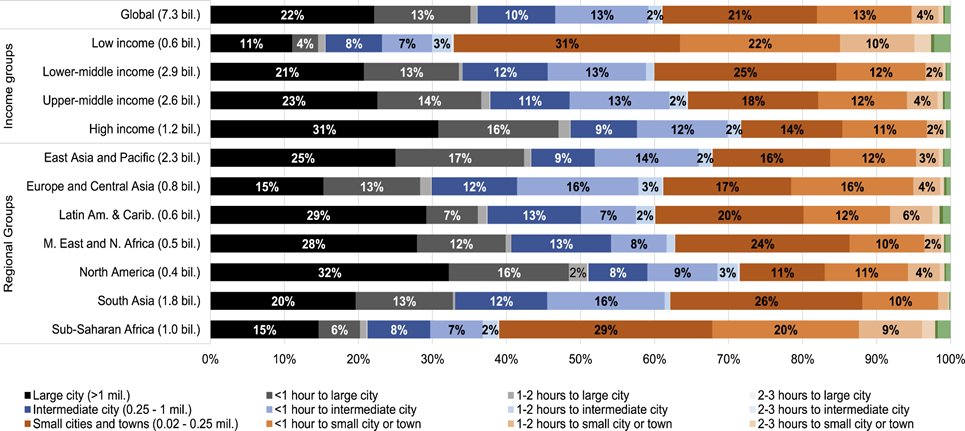Recommended
The vast majority of out-of-school children around the world live in rural areas. For children who live in rural areas and who are enrolled in school, they are less likely to finish primary school or to transition to secondary school. They score worse on tests. Less educational attainment and lower skill development translate to lower incomes and worse life outcomes.
Rural communities, then, face twin challenges: they have the greatest need to expand education, and they have the greatest need to improve the quality of education they provide. In a recently published review, we (with other authors) discuss some of the challenges to providing education in rural areas, potential solutions, and—with newly available data—propose how going beyond a simple urban-rural dichotomy can help countries to tailor solutions to each community.
Why is it so challenging to provide quality rural education?
First, it’s tough to provide any education in rural areas. People are more spread out, so the cost of providing schooling for a hundred students is higher—either because systems need to provide more schools or because they need to provide more transportation to help students cover longer distances. The documentary film On the Way to School depicts twelve-year-old Zahira traveling four hours each way to reach her junior secondary school in Morocco. While that might sound extreme, people in villages in rural Guinea-Bissau said that the average walking distance to a village with a secondary school was more than six hours. Lower-quality roads both make it more difficult for students to travel and for education systems to deliver materials to construct schools.
Second, it’s even tougher to provide high-quality education in rural areas. Most teachers don’t want to work in remote schools, which means that there are fewer teachers, and they tend to have lower skills, coupled with higher rates of turnover and absenteeism. Women teachers, in particular, are less likely to work in remote schools. Schools tend to have fewer complementary teaching materials (like blackboards) in rural areas. Students are more likely to be malnourished, which makes it harder for them to concentrate and process information, and they’re less likely to have resources at home to complement their education—from books to funds for tutoring to complement schooling.
Looking for solutions beyond the urban-rural dichotomy
The difference between rural and urban schools is much more complicated than just those two categories. Yet one of the challenges of implementing effective policies that meet the distinctive needs of rural and remote schools is lack of data. Now, a new global data set maps the continuum of country populations based on how far they are from urban centers (see figure). What we often call “urban” could mean a large city or a small city; what we call rural could include being an hour from a large city or three hours from a small city. The difference in access to services is dramatic. Communities an hour away from a large urban center may find it far easier to attract highly qualified teachers than villages three hours from a small city.
Figure: The world’s population is distributed much more broadly than just urban versus rural
Source: Cattaneo, Nelson, and McMenomy (2021)
Some countries already incorporate these kinds of gradations, and better data can help. Zambia, for example, in 2008 established a simple, twenty percent bonus for teachers in rural schools, but the rules determining who received the bonus were complex: they depended on distance to the nearest bank, the nearest police station, and more. In 2010, the government simplified the rules but increased variation in the bonus: it was entirely determined by distance to the nearest district center, but the size of the bonus fell into one of four categories, depending on how far the school was.
These new data can complement other tools. A new geospatial tool to map localities within countries where children have the least access to schools (“education deserts”), for example, shows how just 350 schools in Guatemala—if placed as recommended by the data—would have had a similar impact in getting children closer to schools as the 7,000 schools that were actually built between 2008 and 2018.
In a time when education budgets are squeezed, more granular data on how far populations live from urban amenities and from existing schools can increase the efficiency of education spending by making sure that resources get to the schools where they can ensure every child receives an education. Finer data can allow more efficient targeting incentives to coax teachers to the most challenging schools. Finer data can allow better allocation of teachers able to teach children in a language they already speak and thus speed their process in reading and writing. These data—combined with household surveys—can help to more effectively target complementary resources (like menstrual pads for girls) that are particularly difficult to access in the most remote areas.
Data, by themselves, aren’t the solution. But new, better data on the urban-rural continuum can help governments and partners to identify barriers, evaluate possible solutions, and design and implement policies to help all children—not just those in urban, better connected areas—to thrive and realize their full desired potential.
Many thanks to Amina Mendez Acosta for data analysis underlying this post and for helpful feedback.
Disclaimer
CGD blog posts reflect the views of the authors, drawing on prior research and experience in their areas of expertise. CGD is a nonpartisan, independent organization and does not take institutional positions.
Image credit for social media/web: jayant khedekar / Adobe Stock







